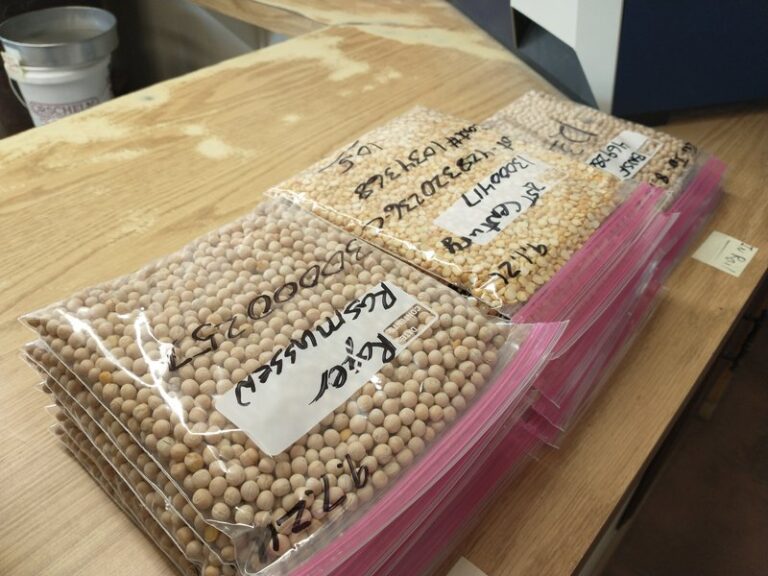LINCOLN, Neb. — For years, consumers have been eating more and more dry peas, chickpeas, lentils and beans.
Bags of lentils or canned chickpeas aren’t a surprising sight in a grocery store, but a closer eye may reveal some surprising bean and pea products on the shelves.
There’s PeaTos, which are similar to Cheetos but made from peas. Their tagline is “Junk food taste, made from peas.”
In the freezer aisle there’s alternative meats, like Beyond Meat’s “ground beef.” The two top ingredients are water, then pea protein.
The latest data from the United States Department of Agriculture estimates that people are consuming two more pounds of legumes per year than they were in 2000, and experts see that climb continuing.
Most of the crops behind those products come from northern states like North Dakota, Montana and Idaho, but states in the Great Plains are becoming increasingly important to meet rising demand.
Farmers Consider Peas
Eric Thalken is one of the farmers growing the main ingredients in those PeaTos or Beyond burgers. He harvested peas in July on his organic farm in southeast Nebraska.
He chose to plant them because they work well as a third crop in his corn and soybean rotation. Peas fit into his planting and harvest schedule and use less water while adding nutrients to the soil as they grow.
“It feels like the ground is more energetic after peas,” Thalken said. “We’ve grown like double crop corn, no additional fertilizer. Everything always looks really good after peas.”
Roland Rushman has been growing pulses — the industry word for peas, beans and lentils — for a little over a decade at his farm in western Nebraska. The crops thrive in drier climates with sandier soils, and are particularly suited in rotation with wheat.
Since they use less water and inject the ground with organic matter, they work well as an alternative to fallowing, when farmers choose not to plant anything and allow the soil to recover. With beans and peas, farmers can rehabilitate their fields and collect a paycheck.
“Instead of a fallow crop, they add nitrogen in the soil and they’re a good cash crop,” Rushman said. “It seems to fit like a glove out in the panhandle.”
Commission Formed
Thalken and Rushman are board members on the state’s recently formed Dry Pea and Lentil Commission, which aims to coordinate research, advocacy and crop insurance for farmers interested in trying out peas.
The group will also help farmers learn to overcome the challenges of growing peas.
“There’s a couple problems and one is that it’s really hard to harvest,” Thalken said. “This harvest is very slow and difficult. We might harvest 40 acres a day here, where soybeans we could do 130.”
Another obstacle is the unpredictability of pricing: last year, pea prices fell to their lowest in a decade. This year, they’ve rallied to near all-time highs in some regions.
Strahinja Stepanović helped farmers learn about pulse production in his work as an extension educator with the University of Nebraska-Lincoln. He said growing peas can offer long-term advantages like soil health and weed reduction, but some farmers can’t justify the obstacles over delayed benefits.
“Out of 600 farmers I’ve talked to, maybe 100 are sold on it and doing it every year and even increasing acres. The majority think that they’ll grow when the price is good or when they can fit them in, and then 20% say ‘No, I’m never going to grow them again,’” Strahinja said. “It all depends on the personality of the farmer.”
Rushman said the global demand for pea and bean products is driving the momentum for new resources in the region. Companies are also betting that the Great Plains will work well as a source and logistics center.
Processing Peas
One company that’s hoping to cash in is Columbia Grain International. The supplier recently bought a plant in Hastings, Nebraska, previously owned by Gavilon, and plans to expand pea operations to eventually process 50,000 tons per year.
The plant will clean and prepare the crops for sale, and then sell the peas to become a part of government food aid tenders, pet food or an alternative flour or meat.
Tony Roelofs heads up the pulse crops division for CGI. He said he hopes the plant fills a gap for farmers in the region.
“I think that’s been the biggest struggle for farmers in the areas,” he said. “They just haven’t had a consistent demand or consistent market for their pulses.”
The Great Plains plant makes sense as domestic demand for pulses grow, Roelofs said. Its central location simplifies shipping logistics and rising supply from the Great Plains helps meet consumer appetites.
Marvin Fast manages the plant for CGI and has been fielding calls from farmers interested in learning more about growing peas. He said he was born and raised with corn and soybeans, but working with peas has been a rewarding change.
“We’re taking it from the farm and then sending out a clean product and actually seeing it in a grocery store. That’s really cool to me.”
The commission, a dedicated facility and this year’s high prices give advocates hope that Great Plains farmers could start planting more peas and beans.
They’re confident the demand for pea and bean products will continue to increase. But they also acknowledge the risks of trying something new could dissuade some growers from giving peas a chance.

